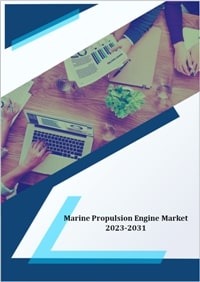
Marine Propulsion Engine Market Is Projected to Expand At A CAGR Of 4.2% Between 2023 And 2031. Propulsion engines in the marine industry is essential to propel the marine asset against natural forces (air & water drag), decelerate & stop, and to keep it in the desired position at the surface or under water. Steering of ships on surface or underwater is not possible without propulsion, as all its rudders work dynamically to overcome waters buoyancy force. In case of non-propelled barges, crawling can be used in assistance with its anchor pattern to move the marine asset along the sea floor. This crawling is recommended for only a few meters since the sea bed is comparatively soft and muddy. Nowadays, even construction barges are being made self-propelled to reduce overall operational costs. Marine propulsion engines are powered by internal combustion engines that derive their power from heavy fuel, diesel oil, natural gas, solar power, wind turbines, and LNG.
A marine propulsion engine consists of three parts: an energy source (human/animal rowing, fuel energy, and energy collected from external source like wind and solar power), an engine that transforms it into mechanical energy, and a thruster that pushes the water backwards for its forward movement. During 18th century, steam engines and paddle wheel was used as thruster for mechanical propulsion of ship. Due to advancement in technologies, the steam engine was slowly replaced by the diesel powered engines with reduced engine size, lower maintenance and suitable for longer voyages. Diesel-electric engines were introduced after 1900’s that reduced the shaft length to the propellers. The gas turbines replaced boilers in steam engines and eventually reduced the overall size of the propulsion system.
When the ship’s cargo is a fuel (oil tankers, LNG tankers, LPG Tankers) it could be used as fuel to propel the ship. LNG is the costliest of all marine fuels and hence if it is the only fuel being used, marine operation would be un-economical as the cost involved to maintain its cryogenic condition is very high. Modern LNG marine propulsion system uses dual-fuel diesel engines (marine diesel oil and natural gas burnt in a 4-stroke engine) and electrically driven propellers with high operational efficiency and very low on emissions.
Based on the engine type, the marine propulsion engine market is segmented into 2-stroke engine and 4-stroke engine. As of 2023, globally, 2-stroke engines dominated overall market value. With stringent mandates on sulfur reduction in fuels and overall marine pollution reduction, 4-stroke engines have gained immense impetus for its high operational efficiency. Thus, the 4-stroke engine type is expected to register the highest growth rate during the forecast period. Based on the energy source, the market is segmented into diesel oil, natural gas, and others (nuclear, solar, wind, etc.). Diesel oil energy source dominated the market in 2017 and a similar trend is expected during the forecast period. Based on vessel type, the market is segmented into bulk carriers, container ships, passenger ships, barges, and others (yacht, offshore support vessels, tugs, etc.)
Geographically, the region with the largest market share of the market was Asia Pacific (APAC) in 2023. APAC is the major trade hub globally with important ports like Singapore port, Shanghai, Hong Kong, and port of Chiwan amongst others contributing to most of the trade activities. Europe is expected to follow APAC closely on account of the high development and oil and gas sector in the North Sea. Despite high oil & gas activities and trades in the North America and European regions as of 2023, the MEA and Latin America are expected to register higher growth rates that the two matured markets due to growth in oil & gas exploration and sea trade activities.
Key players across the Marine Propulsion Engine Market value chain are:
Mitsubishi Motors Corporation, MAN Energy Solutions, Mitsubishi Heavy Industries, Ltd., Kawasaki Heavy Industries Ltd, Wärtsilä Oyj Abp, Caterpillar Inc., LTD., DAIHATSU DIESEL MFG.CO., LTD., Scania, Nigata Power Systems Co., Ltd., YANMAR CO., Fairbanks Morse Engine, General Electric Company, Masson-Marine, among others.
Historical & Forecast Period
This study report represents analysis of each segment from 2022 to 2032 considering 2023 as the base year. Compounded Annual Growth Rate (CAGR) for each of the respective segments estimated for the forecast period of 2024 to 2032.
The current report comprises of quantitative market estimations for each micro market for every geographical region and qualitative market analysis such as micro and macro environment analysis, market trends, competitive intelligence, segment analysis, porters five force model, top winning strategies, top investment markets, emerging trends and technological analysis, case studies, strategic conclusions and recommendations and other key market insights.
Research Methodology
The complete research study was conducted in three phases, namely: secondary research, primary research, and expert panel review. key data point that enables the estimation of Marine Propulsion Engine market are as follows:
Market forecast was performed through proprietary software that analyzes various qualitative and quantitative factors. Growth rate and CAGR were estimated through intensive secondary and primary research. Data triangulation across various data points provides accuracy across various analyzed market segments in the report. Application of both top down and bottom-up approach for validation of market estimation assures logical, methodical and mathematical consistency of the quantitative data.
| ATTRIBUTE | DETAILS |
|---|---|
| Research Period | 2022-2032 |
| Base Year | 2023 |
| Forecast Period | 2024-2032 |
| Historical Year | 2022 |
| Unit | USD Million |
| Segmentation | |
Engine
| |
Energy Source
| |
Vessel
| |
|
Region Segment (2022-2032; US$ Million)
|
Key questions answered in this report